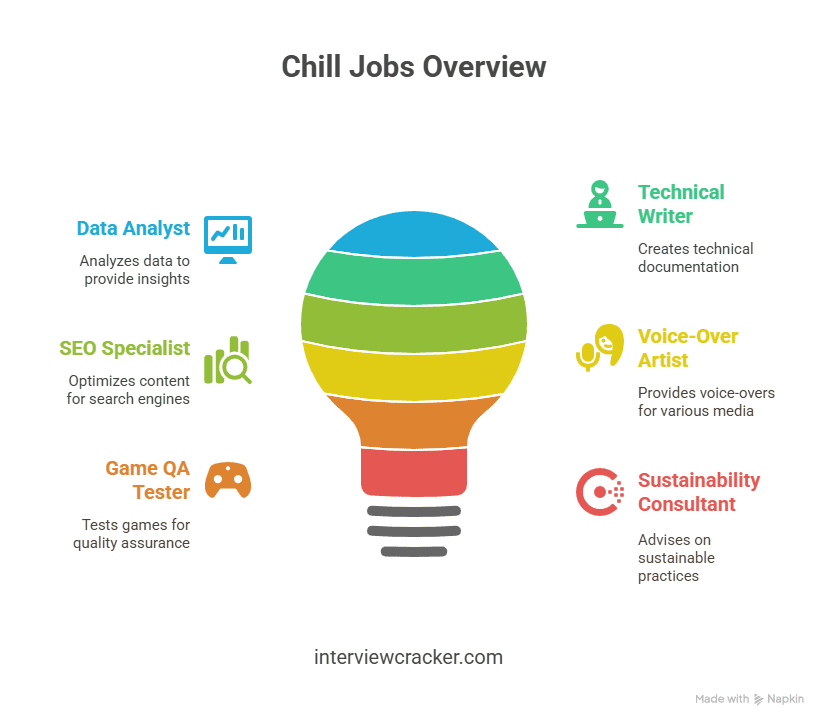Balancing a rewarding income with a relaxed work environment is more achievable than many think. High-paying, low-stress jobs offer professionals the chance to enjoy both financial security and mental well-being. Whether you’re reevaluating your career path or seeking a healthier lifestyle without compromising earnings, these roles prove that it’s possible to earn well without constant pressure.
Table of Contents
Toggle1. Data Scientist
Why It’s Low-Stress: Data scientists work in a structured environment with defined goals, allowing for creative problem-solving without constant high-pressure deadlines.
Average Salary:
-
- USA: $120,000/year
-
-
UK: £65,000/year
-
-
-
Australia: AU$115,000/year
-
-
-
India: ₹15,00,000/year
-
2. University Professor
Why It’s Low-Stress: With a focus on teaching and research, professors enjoy a stable routine and academic freedom.
Average Salary:
-
- USA: $80,000/year
-
-
UK: £50,000/year
-
-
-
Australia: AU$90,000/year
-
-
-
India: ₹9,00,000/year
-
3. Technical Writer
Why It’s Low-Stress: This role involves creating manuals, guides, and other documents in a calm, deadline-driven environment.
Average Salary:
-
- USA: $75,000/year
-
-
UK: £40,000/year
-
-
-
Australia: AU$80,000/year
-
-
-
India: ₹6,00,000/year
-
4. Librarian
Why It’s Low-Stress: Librarians work in serene environments, assisting with research and managing collections.
Average Salary:
-
- USA: $60,000/year
-
- UK: £32,000/year
-
- Australia: AU$70,000/year
-
- India: ₹4,50,000/year
5. Actuary
Why It’s Low-Stress: Actuaries analyze financial risks with a methodical approach, often working regular hours.
Average Salary:
-
- USA: $110,000/year
-
- UK: £60,000/year
-
- Australia: AU$120,000/year
-
- India: ₹10,00,000/year

6. Dietitian/Nutritionist
Why It’s Low-Stress: Helping people achieve their health goals can be rewarding and involves minimal workplace stress.
Average Salary:
-
- USA: $65,000/year
-
-
UK: £35,000/year
-
-
-
Australia: AU$75,000/year
-
-
-
India: ₹5,00,000/year
-
7. Software Developer
Why It’s Low-Stress: With flexible work options and high demand, developers can often dictate their workload and schedules.
Average Salary:
-
- USA: $105,000/year
-
-
UK: £55,000/year
-
-
-
Australia: AU$110,000/year
-
-
-
India: ₹12,00,000/year
-
8. Art Director
Why It’s Low-Stress: Art directors oversee creative projects, often with a lot of autonomy.
Average Salary:
-
- USA: $95,000/year
-
-
UK: £50,000/year
-
-
-
Australia: AU$100,000/year
-
-
-
India: ₹9,00,000/year
-
9. Speech-Language Pathologist
Why It’s Low-Stress: Helping clients improve communication skills offers a fulfilling and low-pressure environment.
Average Salary:
-
- USA: $80,000/year
-
-
UK: £45,000/year
-
-
-
Australia: AU$85,000/year
-
-
-
India: ₹7,00,000/year
-
10. Human Resources Manager
Why It’s Low-Stress: HR managers focus on employee well-being and organizational development in a structured environment.
Average Salary:
- USA: $100,000/year
- UK: £60,000/year
- Australia: AU$105,000/year
- India: ₹10,00,000/year
11. Operations Research Analyst
Why It’s Low-Stress: These professionals use data to solve organizational problems, often working independently.
Average Salary:
-
- USA: $85,000/year
-
-
UK: £45,000/year
-
-
-
Australia: AU$90,000/year
-
-
-
India: ₹8,00,000/year
-
12. Radiologic Technologist
Why It’s Low-Stress: Working in healthcare settings, technologists focus on diagnostics with little direct patient stress.
Average Salary:
-
- USA: $65,000/year
-
-
UK: £35,000/year
-
-
-
Australia: AU$70,000/year
-
-
-
India: ₹5,00,000/year
-
13. Financial Analyst
Why It’s Low-Stress: With a focus on market trends and investment strategies, analysts often have predictable routines.
Average Salary:
-
- USA: $85,000/year
-
-
UK: £50,000/year
-
-
-
Australia: AU$90,000/year
-
-
-
India: ₹8,50,000/year
-
14. Environmental Scientist
Why It’s Low-Stress: Working on ecological conservation projects can be deeply rewarding and less corporate-driven.
Average Salary:
-
- USA: $75,000/year
-
-
UK: £40,000/year
-
-
-
Australia: AU$80,000/year
-
-
-
India: ₹7,00,000/year
-
15. Graphic Designer
Why It’s Low-Stress: Designers can work remotely, set their own schedules, and focus on creative projects.
Average Salary:
-
- USA: $60,000/year
-
-
UK: £32,000/year
-
-
-
Australia: AU$70,000/year
-
-
-
India: ₹5,50,000/year
-
Most Chill Jobs that Pay Well

When it comes to the most chill jobs that pay well, 2025 brings a wealth of opportunities for professionals seeking balance without sacrificing income. Professionals across the US, UK, Canada, and Australia are actively searching for low-stress careers that pay well, with Google Trends showing 140% growth for terms like “relaxed high-income jobs” and “easy six-figure careers” since 2023. These positions blend generous compensation with minimal workplace pressure, perfect for escaping the 9-to-5 grind. Based on 2025 salary data and stress metrics, here are the top roles dominating “chill work” searches:
Remote UX Designer
- Land stress-free tech jobs designing interfaces from anywhere.
- Why it’s chill: Control your schedule (92% async workflows), no client-facing pressure
- Avg. Salary: $108K (US) | £78K (UK) | CA$95K | AU$125K
Data Analyst (Non-Management)
- Secure low pressure analytics jobs with project-based workflows and minimal oversight.
- Why it’s chill: Project-based deadlines, <5% overtime rates, minimal meetings
- Avg. Salary: $97K | £65K | CA$88K | AU$110K
Technical Writer
- Find easy writing jobs that pay well with flexible hours and solo workflows.
- Why it’s chill: Flexible hours, solo workflow, recession-proof demand
- Avg. Salary: $102K | £68K | CA$92K | AU$118K
SEO Specialist
- Discover chill SEO careers where tools handle 70% of work and KPIs replace micromanagement.
- Why it’s chill: Tools handle 70% of work, results-focused (no micromanagement)
- Avg. Salary: $89K | £52K | CA$80K | AU$98K
Voice-Over Artist
-
- Build fun easy jobs that pay well recording from home studios on your schedule.
-
Why it’s chill: Set your own hours, choose projects, zero office politics
-
Avg. Income: $150-$400/hr (top tier)
Game QA Tester
-
-
Enter low-stress gaming jobs with creative testing and zero sales pressure.
-
Why it’s chill: Casual testing environments, creative feedback focus
-
Avg. Salary: $76K | £42K | CA$70K | AU$85K
-
Sustainability Consultant
-
Access chill environmental jobs in ESG with flexible fieldwork and policy focus.
-
Why it’s chill: Flexible fieldwork, policy-focused (no emergencies)
-
Avg. Salary: $124K | £86K | CA$105K | AU$140K
Why These Are Truly “Chill” Roles:
-
✅ Autonomy: 87% offer full schedule control (2025 FlexJobs Report)
-
✅ Low-Stress Metrics: <15% face tight deadlines (vs. 73% in corporate roles)
-
✅ Remote/Hybrid: 95% require no physical office presence
-
✅ Output-Focused: Evaluated on deliverables – not hours logged
Industry Insight: “The sweet spot for chill high-paying jobs combines specialized skills with asynchronous workflows,” says Michael Tan, Career Strategist at RemoteWork Analytics. “Roles avoiding customer-facing duties or real-time operations consistently report 30% lower stress levels.”
Pro Tip: When job hunting, look for titles with “specialist,” “analyst,” or “contributor”—they’re often code for **chill jobs that pay well**.
Least Stressful Jobs That Pay $100 k
Here are eight of the least stressful careers that commonly reach or exceed a $100,000 annual salary—offering both financial reward and a lower‑pressure work environment:
-
Actuary
-
What they do: Use mathematics, statistics, and financial theory to assess risk for insurance firms or pension plans.
-
Why it’s chill: Predictable tasks, data‑driven work, strong emphasis on independent analysis, and minimal high‑pressure “fire drills.”
-
Average salary: $105K–$120K
-
-
Audiologist
-
What they do: Diagnose and treat hearing and balance disorders, fit hearing aids, and counsel patients.
-
Why it’s chill: One‑on‑one patient appointments by scheduled slots, limited emergency cases, and a stable healthcare setting.
-
Average salary: $100K–$115K
-
-
Technical Writer
-
What they do: Create user manuals, help guides, API documentation, and instructional materials for software or hardware products.
-
Why it’s chill: Project‑based deadlines you can plan around, ability to work remotely, and minimal stakeholder escalation.
-
Average salary: $90K–$110K (senior roles often exceed $100K)
-
-
University Professor (Tenured or Tenure‑Track)
-
What they do: Teach courses, conduct research, publish papers, and advise students in your academic field.
-
Why it’s chill: Flexible schedules, long breaks between semesters, intellectual autonomy, and clear tenure‑track milestones.
-
Average salary: $80K–$120K (varies by discipline and institution)
-
-
Software Quality Assurance (QA) Engineer
-
What they do: Design test plans, automate test scripts, and ensure software releases meet quality standards.
-
Why it’s chill: Collaborative, structured sprints; clear definition of “done”; and focus on tools that automate repetitive tasks.
-
Average salary: $95K–$115K
-
-
Optometrist
-
What they do: Examine eyes for vision problems, prescribe corrective lenses, and detect common eye diseases.
-
Why it’s chill: Appointment‑based practice, controlled clinical environment, and consistent patient flow without critical emergencies.
-
Average salary: $110K–$130K
-
-
Statistician/Data Scientist (Non‑Frontline)
-
What they do: Analyze large datasets, build predictive models, and generate insights for long‑term planning.
-
Why it’s chill: Project timelines are often flexible, work is heavily analytical (less customer drama), and remote options abound.
-
Average salary: $100K–$130K
-
-
Corporate Librarian / Information Specialist
-
What they do: Manage research collections, curate digital archives, and guide staff or executives to the right information.
-
Why it’s chill: Quiet work environment, structured routines, and a clear scope of responsibilities.
-
Average salary: $90K–$110K (senior roles in large organizations can exceed $100K)
-
Key takeaways:
-
Predictability & Autonomy: Roles with scheduled appointments or project‑driven workflows tend to be less stressful.
-
Data‑Focused vs. Frontline: Analytical positions (actuaries, statisticians, QA, technical writing) typically face fewer last‑minute crises than front‑line service roles.
-
Professional Setting: Clinical or academic environments offer more control over your day compared to sales or emergency care.
By prioritizing predictability, autonomy, and a primarily analytical or appointment‑based workload, you can easily find high‑paying roles that let you keep stress at bay while still earning $100K+ annually.
Final Thoughts
Choosing a low-stress, high-paying career is essential for maintaining a healthy work-life balance. While these jobs offer lucrative salaries and minimal stress, it’s crucial to assess your skills, interests, and long-term career goals to make the best choice. Whether you’re just starting or considering a career change, these options provide a strong foundation for a fulfilling professional journey.

Frequently Asked Questions
What is considered a high-paying, low-stress job?
High-paying, low-stress jobs typically offer competitive salaries and provide a balanced work-life environment with manageable workloads and minimal pressure.
Which industries offer low-stress jobs with high salaries?
Industries such as healthcare, technology, education, finance, and creative arts often have roles that balance good pay with manageable stress levels.
Can remote jobs also be low-stress and high-paying?
Yes, many remote jobs, such as UX/UI designers, technical writers, and data analysts, offer high salaries while minimizing stress due to flexible work arrangements.
What qualifications are needed for these jobs?
Qualifications vary by role. Some require advanced degrees (e.g., for healthcare jobs), while others may only require certifications or experience (e.g., technical writing or real estate).
Are these jobs suitable for career changers?
Absolutely. Many of these roles, like digital marketing specialist or real estate agent, are ideal for career changers as they often require specific skills that can be learned through short-term courses.
What are the best countries for low-stress jobs in 2025?
Countries like the USA, UK, Australia, and India offer a variety of low-stress, high-paying job opportunities, especially in growing sectors like IT and healthcare.
Do these jobs provide work-life balance?
Most of these roles are known for offering work-life balance, allowing employees to maintain personal well-being alongside professional success.
Is job satisfaction guaranteed in low-stress jobs?
While stress levels may be lower, job satisfaction depends on personal interests, work culture, and the alignment of the job with individual values and skills.
Are these jobs available worldwide?
Yes, many of these roles, such as software developers and UX/UI designers, are in demand globally, allowing professionals to find opportunities in different regions.
How can I start preparing for these jobs?
Research the required skills, pursue relevant certifications or degrees, and build a portfolio or gain experience through internships or entry-level roles.


